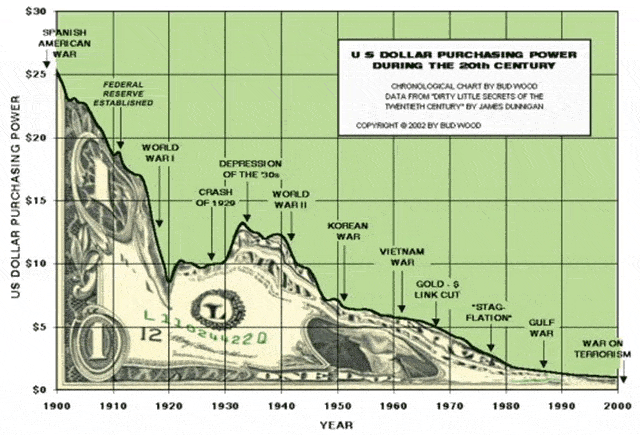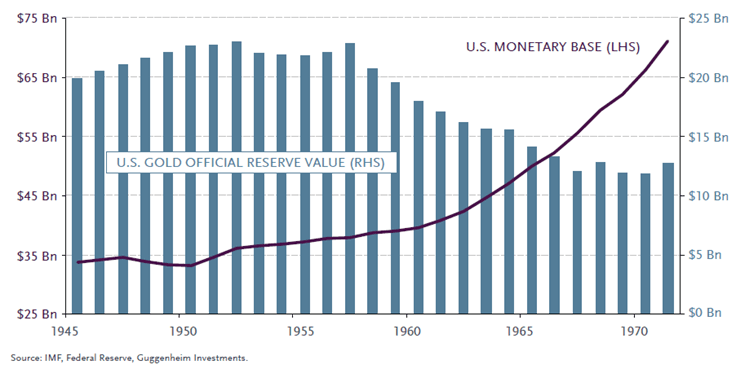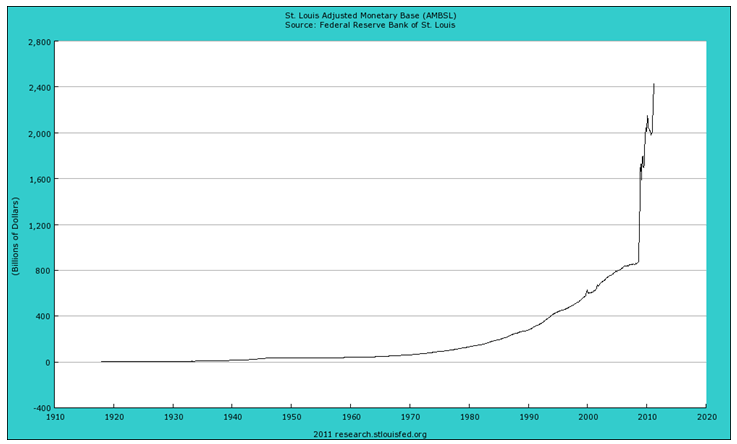We often read or hear quotes like “paper money eventually fail” and “paper money always returns to its intrinsic value which is zero.” In this article, we provide evidence why these statements are true, backed by research in which 599 different forms of paper money have been analyzed. We explain in an easy to understand way what money fundamentally is, how monetary policies of governments are affecting everyone of us and how gold is first and foremost an alternative form of money (for each and every one of us, not only for an elite). Courtesy of Vince Cate for the incredibly valuable research and David Morgan who referred us to the research materials.
Gold analysts argue that gold is the only form of real money, as it is the only tangible form of money that has survived 5,000 years of monetary history. Against that background, a critical event has taken place on August 15th 1971: former US President Nixon “closed the gold window.” He announced the decision to give up the Bretton Woods agreement (click to see the original version of his speech). What seems to most people a political decision is in reality affecting everyone of us in a way only a minority of people can understand. In fact, it’s touching our lives today more than ever.
President Nixon ended the Bretton Woods agreement, which was a worldwide agreement to use the US dollar as the only world reserve currency. The exchange rates between foreign currencies and the US dollar were fixed at a low rate to stimulate economies worldwide. Moreover foreign holders could redeem their dollars for gold at a fixed rate of $ 35 per ounce. So a certain amount of gold should be held by the US as their reserves. As such, it was a form of a worldwide gold standard. President Nixon however “concluded” it was better for the American citizens to give up the Agreement and – more importantly in our opinion – to entirely cut the tie between the paper money (bank notes and regular coins) and its gold backing, as announced at this point in his speech. The President clearly stated: “Your dollar will be worth just as much tomorrow as it is today. The effect of this action is to stabilize the dollar.” Well, looking at the long term chart of the value of the dollar, it seems that those words were to be taken very, very literally. On the following chart, we see a waterfall decline in the value of the dollar since the 60’s, which only deteriorated after 1971.

The President’s story was that the “international money speculators” were to blame. There has indeed been international pressure on the dollar but a far more important reason – at least in our opinion – was either not told by the President (likely), either not known (unlikely). The fact of the matter is that the US had to deal with an unstable monetary policy which was caused by structural imbalances in the monetary system worldwide. Because of the artificially low exchange rates set in 1944, exports to the US have been rising continuously, leading to excessive holdings of US Treasuries held by central banks (redeemed by US dollars). Foreign holders of US Treasuries and dollars, had to expand their monetary base to “control” the inflation that the US was exporting.
Initially 75% of the US monetary base was backed by gold, while in 1971 that same ratio had reached a lamentable 18%, as appears on the following chart.
Now once monetary stability is given up and government debt is (too) easily created, it’s very hard to leave that path and return to discipline. The path of the least short term resistance paves the way for longer term loss of control. That’s exactly what happened with the dollar in 1971: an unstable monetary expansion in the 60’s questioned the value of the US dollar as a world reserve and its ability to pay the holders of the dollars back in gold (the key principle under the Bretton Woods agreements), which lead to distrust. That’s the real story in our opinion and a much more important one which should have been told the hard working citizens.

Now in an earlier article, we wrote that a stable monetary expansion is a condition for economic stability. A fixed amount of Gold compared to the monetary base has a stabilizing effect in terms of economic growth. Since 1971, that important moment in time, the whole world was cut from a gold standard and it hasn’t been restored since then. The fact that the whole world is living for 40 years on a monetary system that is backed by nothing is frightening, given all the above and what you’ll read in the next chapters. Who could realize back then, when listening to the speech of President Nixon, that his measures would be felt two generations later?
What is of particular interest to us, is the viability and the future of a purely paper based money system like the one we have today. The dollar, the euro, the yen are all called “fiat money” because they aren’t backed by anything tangible. In its essence, paper banknotes were only a promise from the bank to exchange it for a certain amount of a real asset (almost always gold or silver). Over the past four decades however, the concept of money has been reduced to the promise, cutting every tie with a real backing asset. That’s why it’s called fiat money. Do you see what money IN ESSENCE is and what it HAS BECOME?
Taking the above insights into account, you should rightfully worry when looking at the following chart. The chart represents the monetary base in the US (very often mentioned in the blogosphere and internet press, see more monetary and gold charts). The chart shows the situation in the US only, but it is critical to understand that the whole world lives on a paper based money system today. The scale is unprecedented.

The monetary environment we are living in, is a ticking time bomb. The evidence is there by looking back in time and see what happened in similar monetary environments. We have been searching for historical evidence for a longer time but only found very recently the type of research we have been looking for. Vince Cate wrote an excellent piece that was presented by the well respected David Morgan during the Silver Summit 2012 (at the end of October). The researcher analyzed 599 paper based money forms over the past millennia. We are privileged to publish the conclusion of the research:
Isn’t it spectacular the number of paper money currencies no longer in circulation? This analysis includes 599 paper money currencies that have ceased to be used as money.
Of these 599 dead paper currencies:The figures are clear. ALL the 599 analyzed paper money systems did disappear.
The Second World War saw at least 95 currencies vanish as nations were conquered and liberated. Next to this, however, hyperinflation is one of the greatest calamities to strike a nation.
- (30%) 184 ended monetary unions, dissolution or other reforms, such as the creation of the Euro in 1999 (and its physical use since 2002);
- (15%) 94 ended through acts of independence (former colonial states renaming or issuing new currency);
- (27%) 156 were destroyed by hyper-inflation (caused by over-issuance of paper money by governments and central banks);
- (28%) 165 were destroyed by war (deemed invalid through military occupation or liberation).
Furthermore, the study pointed out that the median age for all existing “paper currencies” in circulation is only 38 to 39 years. Earlier in this article, we mentioned the 15th August 1971,which marked the end of Bretton Woods and the start of the US dollar as the world reserve currency backed by nothing but promises and trust. That’s 41 years and 4 months ago.
Additionally, we have summarized a couple of valuable insights from the study:
- The British Pound, as defined in 1560, originally represented one troy pound of sterling silver.
- In order to finance the wars with both France and Scotland, Henry VIII reduced the precious metal content of the English coins, enabling him to mint more of them, increasing the nominal value in circulation but slowly eroding confidence in the coinage.
- Paper banknotes were first issued in Britain shortly after the establishment of the Bank of England in 1694.
- As of January 2009 it takes £82.50 to purchase that same troy pound of sterling silver bought for £1 four-hundred-and-fifty years ago – a loss of value equaling 98.8%.
Do you see why gold is called “sound money”? Do you see the untold necessity to hold physical gold and silver, to protect from what is coming sooner or later?
Readers looking for more in-depth insights are advised to visit this research page. It contains an incredible amount of insights and historical data related to money and currencies, gathered by Vince Cate.
In closing, we want to share some food for thought for the reader. David Morgan mentioned in his speech at the Silver Summit 2012: “There is only truth in the universe and resistance to it”. Think about it. If all of the above has empirically be proven, then why do our policy makers continue on this path?

No comments:
Post a Comment